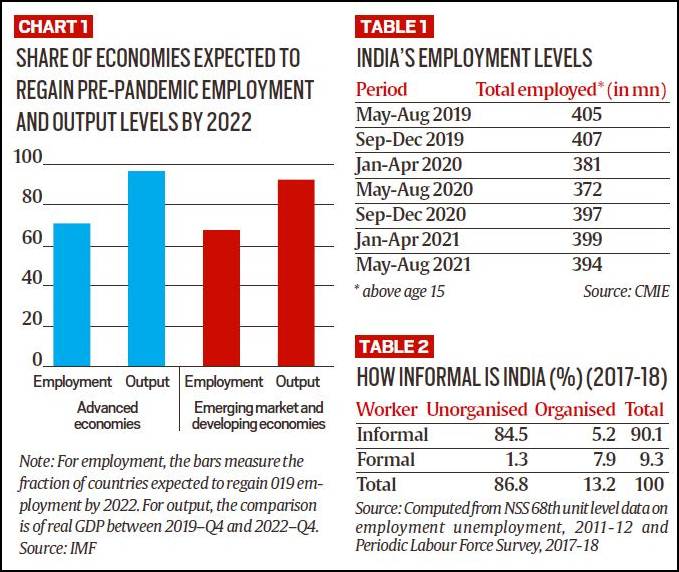ForumIAS announcing GS Foundation Program for UPSC CSE 2025-26 from 19 April. Click Here for more information.
ForumIAS Answer Writing Focus Group (AWFG) for Mains 2024 commencing from 24th June 2024. The Entrance Test for the program will be held on 28th April 2024 at 9 AM. To know more about the program visit: https://forumias.com/blog/awfg2024
Contents
Synopsis: The IMF’s latest World Economic Outlook has underlined that employment growth is likely to lag output recovery after the pandemic. Why has job growth been slow, and what are the concerns for India?
Introduction
Last week, the IMF unveiled its 2nd World Economic Outlook (WEO). The IMO comes out with the report twice every year — April and October — and also provides regular “updates” to it on other occasions.
As per the report, the global economic recovery momentum has weakened a little, largely due to the pandemic-induced supply disruptions.
But more than just the marginal headline numbers for global growth, it is the increasing inequality among nations that IMF was most concerned about.
What are the key findings of the report?
i). Divergence in growth: Aggregate output for the advanced economy group is expected to regain its pre-pandemic trend path in 2022 and exceed it by 0.9 per cent in 2024. By contrast, aggregate output for the emerging market and developing economy group (excluding China) is expected to remain 5.5 per cent below the pre-pandemic forecast in 2024, resulting in a larger setback to improvements in their living standards. There are two key reasons for this: large disparities in vaccine access, and differences in policy support.
ii). Employment growth is likely to stay behind the output recovery: The gap between recovery in output and employment is likely to be larger in emerging markets and developing economies than in advanced economies. Further, young and low-skilled workers are likely to be worse off than prime-age and high-skilled workers, respectively.
What does this mean for India?
According to the data available with the Centre for Monitoring Indian Economy (CMIE), the total number of employed people in the Indian economy as of May-August 2021 was 394 million — 11 million below the level set in May-August 2019. To puts these numbers in a larger perspective, in May-August 2016 the number of employed people was 408 million. In other words, India was already facing a deep employment crisis before the Covid crisis, and it became much worse after it.
Impact on employment post-COVID: Projections of an employment recovery lagging behind output recovery, as made by the IMF in its latest report, could mean a large section of the population being excluded from the GDP growth and its benefits. Lack of adequate employment levels would drag down overall demand and thus slowing down India’s growth momentum.
Why could employment lag output growth in India?
There are several possible reasons.
i). India’s already existing massive unemployment crisis.
Experts cite a number of additional issues too.
ii). Different rates of recovery: India is witnessing a K-shaped recovery. That means different sectors are recovering at significantly different rates. Some sectors such as the IT-services sectors have been practically unaffected by Covid, while e-commerce industry is doing “brilliantly”. But at the same time, many contact-based services, which can create many more jobs, are not seeing a similar bounce-back. Similarly, listed firms have recovered much better than unlisted firms.
iii). Bulk of India’s employment is in the informal or unorganized sectors. Typically, it is expected that organised sector firms will provide formal employment. Recently, IMF Chief Economist Gita Gopinath pointed out that the number of people using the MGNREGA provisions was still 50-60% above pre-pandemic level. This suggests that the informal economy is struggling to recover at the same pace as some of the more visible sectors. A weak recovery for the informal/unorganised sectors implies a drag on the economy’s ability to create new jobs or revive old ones.
Source: This post is based on the article “Explained: IMF outlook and status of jobs” published in The Indian Express on 20th Oct 2021.





